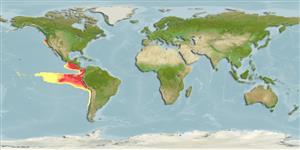>
Lophiiformes (Anglerfishes) >
Oneirodidae (Dreamers)
Etymology: Ctenochirichthys: Greek 'kteis', 'ktenos' = comb + Greek, 'cheiros' = hand (or its evolutionary homolog, the pectoral fin) + Greek, 'ichthys' = fish (Ref. 86949).
More on authors: Regan & Trewavas.
Environment: milieu / climate zone / depth range / distribution range
Ecologie
marien bathypelagisch; diepte 800 - 1000 m (Ref. 86949). Deep-water
Pacific Ocean: Chile and Panama.
Grootte / Gewicht / Leeftijd
Maturity: Lm ? range ? - ? cm
Korte beschrijving
Morfologie | Morfometrie
Dorsale zachte stralen (totaal): 6-7; Anale zachte stralen: 4 - 5. Metamorphosed males and females have an extremely long pectoral fin lobe, bearing high number of pectoral fin rays, inserted along dorsal margin and an elongate, slender subopercular bone, tapering only slightly, dorsal end rounded or squared off. Metamorphosed females are further unique in having the following characteristics: presence of vomerine teeth; convex dorsal margin of frontal bones; reduced sphenotic spines; lower jaw with small symphysial spine; hyomandibula with double head; small quadrate and articular spines; deeply notched posterior margin of opercle; elongate and slender subopercle throughout its length, ventral end elongate and rounded; well developed second pharyngobranchial; caudal fin rays without internal pigmentation; illicium longer than length of esca bulb; pterygoiphore of illicium cylindrical throughout its length, emerging on snout from between frontal bones, anterior end exposed, posterior end concealed beneath skin; well developed first ray of dorsal fin; dorsal fin rays 6-7; anal fin rays 4-5; extremely long and narrow pectoral fin lobe, longer than longest rays of pectoral fin; pectoral fin rays 28-30; skin presumably naked, without dermal spinules; darkly pigmented skin of caudal peduncle extends well past base of caudal fin (Ref. 86949). Metamorphosed males: have 13 olfactory lamellae; 9 upper denticular teeth arranged in two rows, inner row with 8 teeth, outer row with 3 teeth; naked skin, without dermal spinules (Ref. 86949). Larvae: elongate body; depth of body and length of the head measures 40-45% of SL; concentration of pigment lies medial to subopercle; dorsal pig mentation restricted to anterodorsal part of body (Ref. 86949).
Levenscyclus en paargedrag
Maturiteit | Voortplanting | Paaien | Eieren | Fecunditeit | Larven
Pequeño, G., 1989. Peces de Chile. Lista sistematica revisada y comentada. Rev. Biol. Mar., Valparaiso 24(2):1-132. (Ref. 9068)
Status op de Rode Lijst van het IUCN (Ref. 130435)
Gevaar voor de mens
Harmless
Gebruik door de mens
Meer informatie
Lokale namenSynoniemenMetabolismePredatorenEcotoxicologieVoortplantingMaturiteitPaaienPaaiaggregatiesFecunditeitEierenOntwikkeling van de eieren
Leeftijd/GrootteGroeiLengte-gewichtLengte-lengteLengtefrequentiesMorfometrieMorfologieLarvenLarvale populatiedynamiekRekruteringAbundantieBRUVS
ReferentiesAquacultuurAquacultuurprofielKweeklijnenGeneticaElectrophoresesErfelijkheidZiektesVerwerkingNutrientsMassaconversie
Tools
Speciale rapporten
Download XML
Internetbronnen
Estimates based on models
Preferred temperature (Ref.
123201): 1.7 - 2.6, mean 1.9 °C (based on 168 cells).
Fylogenetische diversiteitsindex (Ref.
82804): PD
50 = 1.0000 [Uniqueness, from 0.5 = low to 2.0 = high].
Bayesian length-weight: a=0.01995 (0.00906 - 0.04395), b=3.01 (2.83 - 3.19), in cm total length, based on all LWR estimates for this body shape (Ref.
93245).
Trofisch niveau (Ref.
69278): 3.8 ±0.5 se; based on size and trophs of closest relatives
Weerstandsvermogen (Ref.
120179): Hoog, minimale populatieverdubbelingstijd minder dan 15 maanden (Preliminary K or Fecundity.).
Fishing Vulnerability (Ref.
59153): Low vulnerability (10 of 100).
